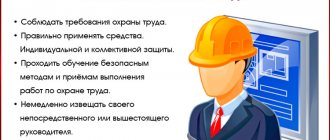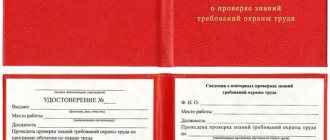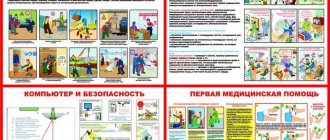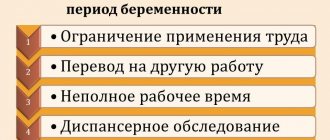Concept of labor protection
What is labor protection at an enterprise and why is it needed is stated in Article 209 of the Labor Code.
Occupational safety in Russia is a system or set of measures aimed at protecting the health of an employee during his work activity. The main occupational safety measures can be divided into five groups:
- legal (documentation);
- socio-economic (compulsory insurance of employees, payment of compensation, provision of benefits, etc.);
- organizational and technical (special assessment of working conditions in the workplace, personnel optimization, etc.);
- sanitary and hygienic (providing workers with special clothing, footwear and other protective equipment).
- preventive (medical examinations of employees, creation of a system of sports rehabilitation for employees).
Thus, labor protection includes a set of measures aimed at creating safe working conditions for employees and the enterprise as a whole.
Labor protection system
The labor protection system is a system for preserving the life and health of workers. The rules and procedures for labor protection of workers are regulated by the Labor Code of the Russian Federation. Previously, the organization of the labor protection system at the enterprise was carried out on the basis of the provisions of Federal Law dated July 17, 1999 No. 181-FZ “On the fundamentals of labor protection in the Russian Federation.” The Labor Protection Law became invalid on October 5, 2006.
Labor protection for workers includes the creation of a workable labor protection management system in the company (Article 217 of the Labor Code of the Russian Federation).
It is necessary for all organizations and entrepreneurs with more than 50 employees to create an occupational safety service or hire a specialist in this field. Moreover, this condition is true not only for manufacturing employers, but also for those operating in the service sector (letter of the Ministry of Labor dated June 10, 2016 No. 5-2/OOG-2136).
The service will monitor working conditions in a company or individual entrepreneur, monitor the safety of work on equipment, investigate industrial accidents, and train employees.
In an organization employing no more than 50 people, the functions of auditing labor protection according to the Labor Code of the Russian Federation can be assigned to any employee - part-time or part-time. For example, an accountant, HR officer, production department manager or head of the sales department. But only if this person agrees to such changes. If you expand the list of responsibilities unilaterally, then the employee will be able to challenge them in court (decision of the Central District Court of Sochi dated July 3, 2014 No. 2-2795/2014).
In addition, the company needs to develop local regulations on labor protection issues. Firstly, the provision on labor protection. Secondly, a training program on labor protection. Thirdly, instructions on labor protection. It is developed based on the position or profession of the employees.
Responsibilities of an employee in the field of labor protection
The employer has the right to demand that any employee of his company comply with the rules set forth in internal regulations and in the main document of the hired employee (contract). A person may be held accountable for illegal actions.
The responsibilities of all employees under the basic regulatory law regarding labor protection are listed in Art. 214 of the Labor Code of the Russian Federation. The employee is obliged:
- strictly know and comply with all internal rules of the company;
- correctly use types of personal protection and protection of the team as a whole;
- timely learn the necessary methods and techniques for providing emergency assistance to people injured at work;
- undergo training related to the protection of activities and internship at the place of performance of labor functions;
- promptly inform your immediate superior about a situation that has arisen, if it threatens the life and health of people, about an accident, about a change in the state of personal well-being, including the manifestation of any illness;
- undergo examinations before employment and be examined in special institutions;
- undergo testing of the necessary knowledge of labor protection rules;
- be examined in medical institutions according to the lists generated by the employer in situations provided for by labor legislation and other laws adopted in the country.
It is important to know! The responsibility of the employer is to adhere to the agreements reached and recorded. Employees who violate the rules are held accountable.
Responsibilities of certain categories of employees
The manager must comply with the security rules for special categories of employees prescribed in Art. 224 Labor Code of the Russian Federation. Let's list what is required from employers:
- limit their involvement in certain types of work, night work, and overtime;
- transfer people who, due to physical health reasons, need to be offered another job, to other positions, according to opportunities with proportional wages or tariffs;
- arrange periods for rest;
- create specific conditions for professional activity for people with disabilities.
Elements of labor protection
Safety precautions are a system of organizational and technical measures and means that will help prevent employees from being exposed to hazardous production factors;
Fire safety – measures that are aimed at improving the fire safety situation and reducing the risk of fires during work;
Sanitary and hygienic working conditions are a set of measures that are aimed at creating a comfortable microclimate in the workplace and ensuring adequate rest and living conditions on the company’s territory.
Electrical safety is a system of measures that are aimed at protecting against the harmful and dangerous effects of electric current, electric arc, electromagnetic field and static electricity.
Occupational safety management - work to ensure safety, reduce injuries and accidents, occupational diseases, improve working conditions.
Occupational safety 2020 – 2020: new rules
The labor protection legislation was amended in 2020. One of the main changes to the labor protection rules 2020 is the introduction of assessment of professional qualifications in the form of a professional exam, which is conducted by specialized centers. Compliance of qualifications with professional standards can be at the initiative of both an individual and an employer.
Another innovation is the new GOST standards for labor protection from 2020. Additional requirements for physical factors in the workplace are established by the new SanPiN 2.2.4.3359-16. The document lists standards for illumination, vibration, electromagnetic fields, microclimate, noise, radiation, ultra- and infrasound. Non-compliance with standards and the presence of harmful factors can be identified in the process of conducting a special assessment of working conditions.
In addition to SanPiN 2.2.4.3359-16, other regulations on labor protection – 2020 have been adopted:
- Organization of occupational safety training - GOST 12.0.004-2015;
- Hazardous and harmful production factors - GOST 12.0.003-2015;
- Signal colors, safety signs and signal markings - GOST 12.4.026-2015;
- Occupational safety management system - GOST 12.0.230.1-2015, GOST 12.0.230.2-2015.
Changes in labor protection in 2020 also affected micro-enterprises. Now they may not have to draw up internal labor regulations, wage regulations, bonus regulations, or shift schedules. All issues that are usually enshrined in local acts can be included in employment contracts. Microenterprises can conclude agreements on the basis of the standard form from the Decree of the Government of the Russian Federation dated August 27, 2016 No. 858.
Another amendment to the labor protection rules in 2020 - the Social Insurance Fund will reimburse costs only for personal protective equipment manufactured in the Russian Federation from Russian fabrics, knitted fabrics, and non-woven materials.
Labor safety news
The main news on labor protection - the Ministry of Labor approved the “Road Map” for the abolition and updating of mandatory requirements in the field of compliance with labor legislation and other regulations containing labor law standards.
In particular, amendments are planned for the 2nd quarter of 2020 to the procedure in the event that, based on the results of a special assessment, no harmful or dangerous production factors were identified in the workplace.
Also in 2020, it is planned to change the procedure for training in labor protection and testing knowledge of labor protection requirements.
To learn everything new in labor safety in a timely manner, read labor safety news on the website of the Ministry of Labor of the Russian Federation.
Responsibilities of an employee in the field of labor protection
The employer has the right to demand that any employee of his company comply with the rules set forth in internal regulations and in the main document of the hired employee (contract). A person may be held accountable for illegal actions.
The responsibilities of all employees under the basic regulatory law regarding labor protection are listed in Art. 214 of the Labor Code of the Russian Federation. The employee is obliged:
- strictly know and comply with all internal rules of the company;
- correctly use types of personal protection and protection of the team as a whole;
- timely learn the necessary methods and techniques for providing emergency assistance to people injured at work;
- undergo training related to the protection of activities and internship at the place of performance of labor functions;
- promptly inform your immediate superior about a situation that has arisen, if it threatens the life and health of people, about an accident, about a change in the state of personal well-being, including the manifestation of any illness;
- undergo examinations before employment and be examined in special institutions;
- undergo testing of the necessary knowledge of labor protection rules;
- be examined in medical institutions according to the lists generated by the employer in situations provided for by labor legislation and other laws adopted in the country.
Attention! The responsibility of the employer is to adhere to the agreements reached and recorded. Employees who violate the rules are held accountable.
Responsibilities of certain categories of employees
The manager must comply with the security rules for special categories of employees prescribed in Art. 224 Labor Code of the Russian Federation. Let's list what is required from employers:
- limit their involvement in certain types of work, night work, and overtime;
- transfer people who, due to physical health reasons, need to be offered another job, to other positions, according to opportunities with proportional wages or tariffs;
- arrange periods for rest;
- create specific conditions for professional activity for people with disabilities.
Occupational safety requirements
Labor protection requirements are requirements that establish rules, procedures and criteria aimed at preserving the life and health of workers in the process of work.
What documents set out labor protection requirements? In addition to the Labor Code, labor protection rules obligatory for the employer are prescribed in the following laws and regulations:
- Federal Law of March 30, 1999 No. 52-FZ “On the sanitary and epidemiological welfare of the population”;
- Resolution of the Ministry of Labor of Russia dated 02/08/2000 No. 14 “On approval of Recommendations for organizing the work of the Labor Safety Service in organizations”;
- Order of the Ministry of Health and Social Development of the Russian Federation dated 01.06.2009 No. 290n “On approval of intersectoral rules for providing workers with special clothing, special footwear and other personal protective equipment”;
- Federal Law of December 28, 2013 No. 426-FZ “On special assessment of working conditions.”
Compliance with security requirements is the responsibility of every employer, regardless of what taxation system it uses. The employer is obliged to provide at his own expense:
- safety during operation of equipment, buildings and materials and tools used in the work process;
- use of protective equipment that has passed the declaration of conformity or certification;
- appropriate conditions at each workplace;
- issuing personal protective equipment and disinfectants to employees who work in dirty conditions, uncomfortable temperature conditions or unsafe conditions;
- conducting a special assessment of working conditions;
- working conditions in the workplace that comply with labor protection requirements, their control, sanitary and medical care for workers;
- work and rest schedule.
The full list of employer responsibilities is listed in Article 212 of the Labor Code.
Job responsibilities
The job description defines the following functional responsibilities of a labor protection specialist:
- Ensure the functioning of the system at the enterprise (developing methodological recommendations, conducting conversations with employees, monitoring technical devices, conducting inspections, etc.).
- Organize a regulatory framework. The employee must not only ensure that the enterprise has federal regulations, but also develop local documents. Such documents must be drawn up taking into account the peculiarities of the functioning of a particular organization (direction of activity, hazardous factors, responsibilities of employees, etc.).
- Comply with the requirements existing in this area.
- Use personal and collective protective equipment.
- Undergo training that includes acquiring skills: first aid, safe organization of activities.
- Have the necessary knowledge . Only applicants with the necessary technical education can apply for the position; work experience is desirable. The employee must be familiar with legislative acts and internal documents.
- Notify the manager about unforeseen situations (emergencies, work-related injuries, accidents).
- Notify your manager about the appearance of health problems or signs of occupational diseases.
- Pass inspections that are mandatory: preliminary (during employment) and periodic (during work).
- Undergo unscheduled inspections (if necessary).
- Interact with employee representative bodies (trade unions). Not only take into account their comments and suggestions regarding working conditions and the level of safety at the enterprise, but also notify them about changes made to collective agreements and other documents.
- Determine the need for personnel training , organize and plan this training. As a result, the organization’s employees receive the necessary knowledge, which significantly increases the level of safety at work and reduces the risk of accidents and injuries.
- Develop methodological recommendations for department heads. These recommendations, developed taking into account the specifics of the activity of a particular department, are used by department heads to improve the level of knowledge of subordinates.
- Monitor the level of knowledge acquired by employees by conducting certifications, tests, and surveys.
- Inform employees about the state of the system: compliance of conditions with existing standards, the risk of injury, the risk of accidents at work, the equipment of workplaces, the risk of occupational diseases, the possibility of obtaining guarantees, benefits and compensation.
- Interact with employees , receiving information from them about possible violations and the need for system changes.
- At the request of the employer, prepare the information necessary for the employer to submit to the representative body of employees or government authorities.
- Prepare reports at the request of the employer
- Develop action plans aimed at: increasing labor safety, improving working conditions, increasing employee safety, reducing the risk of accidents.
- Prepare proposals for providing certain categories of employees with benefits, compensation, and guarantees.
- Analyze technical documentation provided during commissioning of various facilities.
- Ensure the organization of inspections of employees: preliminary (during employment), periodic (during work).
- Monitor the equipment of employees with personal protective equipment. Provide supervision over the condition of protective equipment, their proper storage and operation.
- Monitor the installation of collective protective equipment , monitor their condition, storage conditions, operation, etc.
Download the Occupational Safety and Health Specialist job description template here.
Occupational safety and health in the workplace
The employer is obliged to ensure that workplaces comply with labor protection requirements. The location and organization of workplaces, equipment and tools for work, the air environment and other conditions must be safe and not threaten the life of the worker.
To determine how the employer complies with labor protection requirements for the workplace, a special assessment of working conditions at each workplace is carried out.
A special assessment of working conditions is a set of measures with the help of which harmful and dangerous production factors are identified and their impact on the worker’s body is assessed.
All jobs are subject to special assessment, except for homeworkers and remote workers. A special assessment of working conditions should be carried out at least once every five years. This period is counted from the day when the results of the special assessment were approved. Read more in the article “Special assessment of working conditions”.
Labor safety rules and regulations
The employer needs to fix the rules and regulations of labor protection at the enterprise. To do this, first of all, you should:
- systematize shortcomings in the field of worker safety identified during inspections;
- establish irrelevant labor safety standards;
- evaluate the effectiveness of existing rules.
Then it is necessary to draw up and approve a regulation on labor protection. That is, a document that specifies the basic rules of labor protection at the enterprise. To prevent the labor protection provision from becoming cumbersome, do not include in it general labor protection rules that are expressly provided for by law. For example, the provision of free protective clothing and milk to workers in hazardous industries.
It is also possible to include in a separate safety regulation the rules for conducting labor safety briefings and testing the knowledge acquired by employees, and make separate safety instructions for each department.
It is also possible to include in a separate safety regulation the rules for conducting labor safety briefings and testing the knowledge acquired by employees, and make separate safety instructions for each department.
Responsibility of the specialist
The employee is responsible for:
- causing material damage;
- committing an offense (during the performance of professional activities);
- failure to fulfill the duties assigned to him by the job description.
Types of responsibility:
- Disciplinary . Occurs due to unintentional failure to perform, poor performance of duties. For example, allowing workers to access equipment that is in faulty condition . It is expressed in the imposition of a penalty (reprimand, reprimand), or in dismissal.
- Material . Causing material damage. For example, the occurrence of a fire due to the careless actions of a specialist. The employee is obligated to compensate for damage caused to the company. The fact of financial responsibility is usually reflected in the employment contract or in an additional agreement.
- Administrative . Occurs when an administrative offense is committed as a result of non-fulfillment or poor performance of duties. For example, an industrial incident that threatens the life or health of people, which occurred due to the lack of proper control on the part of a specialist over the functioning of the equipment. A preventive measure is the imposition of a fine on a direct official, on an organization, or suspension of the activities of a legal entity.
- Criminal . Gross violation of rules, commission of a criminal offense during the performance of professional duties. Liability arises when actions are committed that cause harm to health or life (or create a serious threat). For example, a violation of safety standards committed at hazardous facilities . A preventive measure is the imposition of a fine, involvement in compulsory or forced labor, imprisonment.
The employer also has responsibilities in the field of labor protection - he must ensure the safety of workers by timely replacement of equipment, training employees in safety procedures according to current requirements, etc.
Find out more about labor protection from the video:
https://youtu.be/HXvz3bBf6UY
Thus, the range of responsibilities of a labor protection specialist is quite extensive. In his activities, an employee must rely on the norms of labor legislation and basic regulations. Failure to fulfill or poor quality performance of duties entails liability.








